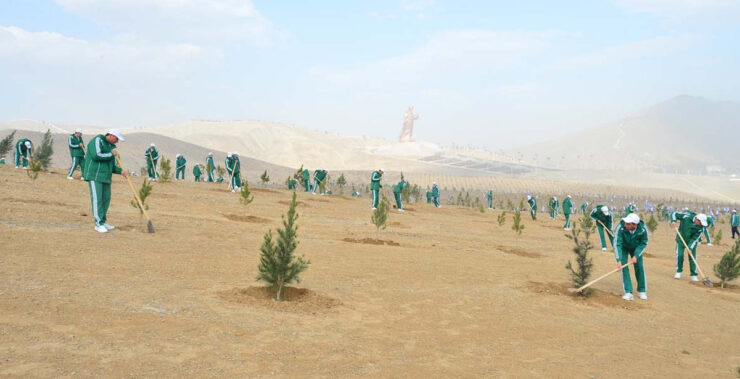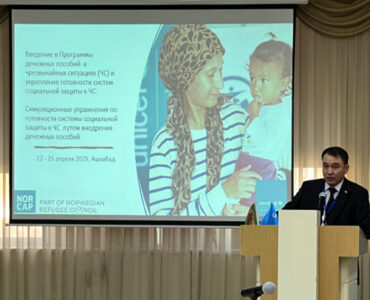Turkmenistan’s president Serdar Berdimuhamedov has ordered the planting of 3 million trees across the country in 2024. This initiative is part of the National Forestry Program (2021-2025), one of the government’s strategies for adapting to climate change and one of the government’s many documents that are not available publicly.
This initiative mandates planting a variety of trees suited to the local climate, including deciduous (trees with leaves), coniferous (trees with needles) and fruit trees, and utilizing water-conservative drip irrigation, a crucial step in a country with arid conditions and limited fresh water supply. Turkmenistan may lose up to 50% of its water supply when Afghanistan completes its canal project diverting water from Amu-Darya and Turkmenistan receives only 161 mm of rainfall annually, in contrast to the global average of 1171 mm (World Bank).
This limited precipitation makes water conservation paramount for the success of the tree-planting initiative. Drip irrigation, a method of watering plants by delivering water directly to their roots through a network of tubes, allows for water to be delivered precisely. This technique minimizes evaporation and maximizes water usage efficiency, making it particularly beneficial for conserving water resources in agriculture and landscaping. The combination of deciduous and coniferous trees offers the advantages of both tree types, as explained on the Orient news site.
Overall, the tree planting initiative is a positive step, but it is important to underscore the uncertainty surrounding the impact, efficiency, diversification, and survivability of these plants in Turkmenistan. The existing academic research on tree planting in Turkmenistan is limited. For instance, Thevs (2021) explores forest restoration focusing on biomass utilization as an energy source or lignin in Central Asia, which may not directly apply to Turkmenistan due to its minimal use of biomass for energy and the absence of a large pulp and paper industry.
Conversely, a study from researchers at the Turkmen State Pedagogical Institute concentrates on safeguarding transportation infrastructure from shifting sands, suggesting the planting of drought-resistant trees and shrubs like saxaul along roads and railways. Another study by Thevs (2014) indicates that water evaporation from canals and water consumption for soil preparation (e.g., leaching salts) significantly contribute to high water consumption during plantation irrigation in Turkmenistan. Additionally, a study by researchers from Korea University evaluates the relevance, readiness, and sustainability of various afforestation projects in Turkmenistan, including one involving the planting of drought and salt-tolerant trees such as saxaul, kandym, and cherkez.
Although the feasibility of all projects is affirmed, the specifics of these projects are not detailed. To ensure the success of tree planting initiatives and maximize their contribution to a more sustainable future, Turkmenistan should prioritize diversifying plantings, ensuring transparency regarding the types of trees planted, water consumption, and locations, and drawing lessons from the experiences of other nations.
Planting trees offers numerous benefits
Trees act as natural air conditioners, releasing water vapor to cool their surroundings, similar to how sweating cools humans. The closer trees are to buildings and homes, the more pronounced this cooling effect will be, so it is important to plant them within urban areas. Also, they absorb carbon dioxide, a major greenhouse gas, helping to combat climate change. Their presence also helps prevent desertification by providing shade and reducing soil erosion. This is particularly important in Turkmenistan, where the World Health Organization (WHO) reports air pollution levels exceeding recommended safety limits. Trees intercept rainfall, slowing the flow of water and allowing it to soak into the ground. This reduces the risk of flash floods and helps to replenish groundwater supplies. Healthy root systems also bind soil particles together, preventing them from being washed away by wind or heavy rain. This is particularly crucial in arid environments like Turkmenistan, where strong winds and limited rainfall can exacerbate soil erosion.
Donate to support Turkmen analysts, researchers and writers to produce factual, constructive and progressive content in their efforts to educate the public of Turkmenistan.
SUPPORT OUR WORKThe project can serve as a good practical experience for the ministries involved, as they can accumulate expertise in tree planting, forestry management, novel irrigation methods and water conservation. However, learning from past mistakes is crucial for long-term success.
Moreover, the readers may have grown used to the news from the state media about tree planting events and projects, including 30 million trees in 2021 and 25 million trees in 2020. As part of climate change mitigation, urban greening and the aforementioned National Forestry Program, the planting of millions of trees have been taking place every year for several years. It is pleasing to see that care and attention is given to the selection of the seedlings, and that they are “adapted to the peculiarities of the soil and climatic conditions” of the areas where they are planted. The latest resolution on tree planting specifies that half of the seedlings must be planted within the Ahal region and 1.5 million in other velayats. The resolution, however, does not specify what trees are to be planted; it only orders the planting of seedlings of deciduous (trees with large leaves), coniferous (trees with needles), and fruit trees and grapes.
Effectiveness of tree planting campaigns
While media reports mention numerous tree-planting projects, assessing their effectiveness remains difficult. Monitoring the progress and survival rates of tree planting projects is a widespread issue around the world, according to researchers from Yale University. The government should track sapling health, survival rates, and environmental impact to measure true success. Reporting beyond vague UN submissions would build trust between the people and the government and its programs and demonstrate the initiative’s true value.
Applying these lessons to Turkmenistan’s greening projects is key:
- Plant diverse tree species: This promotes biodiversity and creates a more resilient ecosystem.
- Prioritize native species: They are better adapted to local conditions and require less maintenance. The prime example and best suited plant for the non-mountainous parts of Turkmenistan are saxauls.
- Implement sustainable water management: Drip irrigation is a good start and tree planting should not endanger the fresh water availability.
- Monitor and adapt: Regularly assess the project’s impact and adjust strategies as needed.






